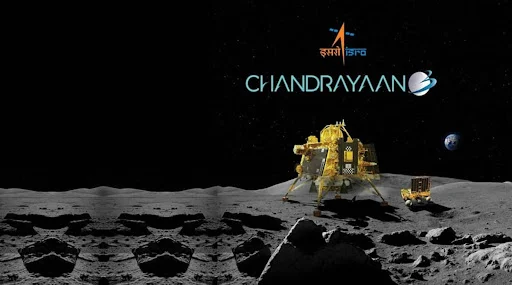INDIA ON MOON SURFACE
Summary
Chandrayaan-3 is a follow-on mission to Chandrayaan-2 to demonstrate end-to-end capability in safe landing and roving on the lunar surface. It consists of Lander and Rover configuration. It will be launched by LVM3 from SDSC SHAR, Sriharikota. The propulsion module will carry the lander and rover configuration till 100 km lunar orbit. The propulsion module has Spectro-polarimetry of Habitable Planet Earth (SHAPE) payload to study the spectral and Polari metric measurements of Earth from the lunar orbit.
Lander payloads: Chandra’s Surface Thermophysical Experiment (ChaSTE) to measure the thermal conductivity and temperature; Instrument for Lunar Seismic Activity (ILSA) for measuring the seismicity around the landing site; Langmuir Probe (LP) to estimate the plasma density and its variations. A passive Laser Retroreflector Array from NASA is accommodated for lunar laser ranging studies.
Rover payloads: Alpha Particle X-ray Spectrometer (APXS) and Laser Induced Breakdown Spectroscope (LIBS) for deriving the elemental composition in the vicinity of landing site.
What is future benefit of Chandrayaan-3?
The Chandrayaan-3 mission will highlight how space is becoming more accessible, and demonstrate India's continued perseverance and tenacity in achieving difficult missions. It also bodes well for India's participation in the new space race to build permanent infrastructure on the Moon.
What is the cost of the Chandrayaan-3?
Chandrayaan-3 cost the nation Rs 615 crore
Why is Chandrayaan-3 important for India?
India's third lunar mission called Chandrayaan-3 made India the first country to successfully land near the Moon's south pole - a region that has piqued the interests of scientists due to its unique characteristics
How long will Chandrayaan-3 stay on Moon?
If it lands successfully, the Chandrayaan-3 is expected to remain functional for two weeks, running a series of experiments including a spectrometer analysis of the mineral composition of the lunar surface
How is Chandrayaan 2 different from Chandrayaan-3?
Instead of a success-based design in Chandrayaan-2, the space agency opted for a failure-based design in Chandrayaan-3, focused on what all can fail and how to protect it and ensure a successful landing. ISRO said that the new mission has been designed to land successfully even if certain elements fail.
Is India the first country to land on south pole of Moon?
The country becomes the fourth to successfully land a spacecraft on the moon, but is the first to touch down on the relatively unexplored lunar south pole. India has become the first country to successfully land a spacecraft on the moon's south pole.
Conclusion
the successful landing of Chandrayaanon th-3 e Moon's surface marks a defining moment in India's journey of space exploration. This achievement showcases the nation's scientific prowess, determination, and unwavering commitment to pushing the boundaries of human knowledge.
Tags
Space News



